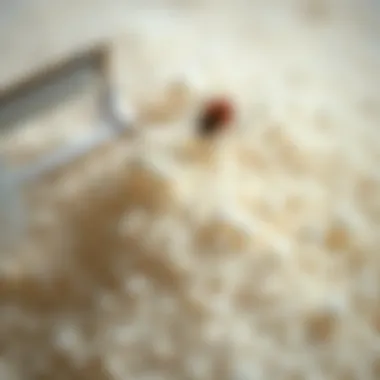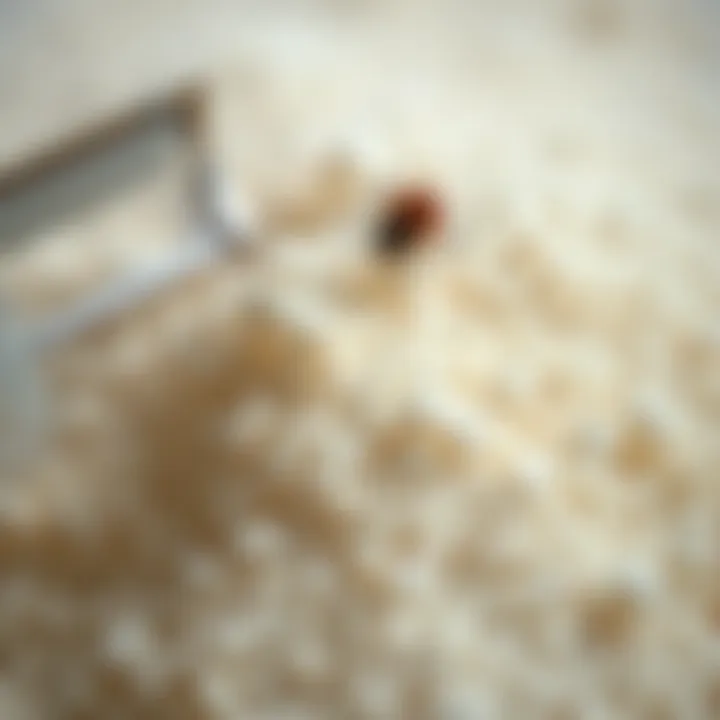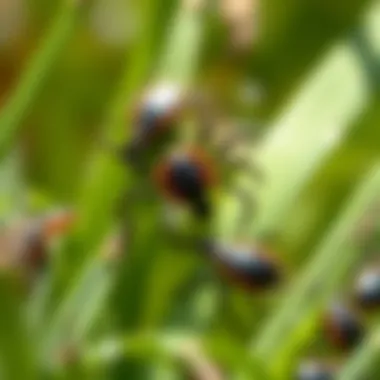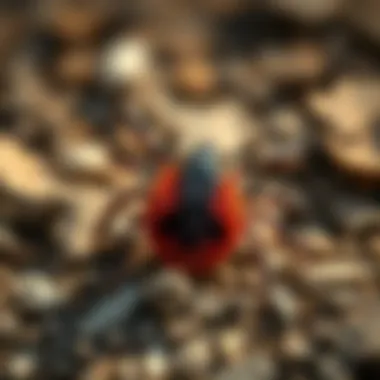Effective Tick Control Using Diatomaceous Earth


Intro
In every slice of nature, small creatures emerge that can cause big headaches—ticks are among the most notable. Commonly found in yards, these arachnids can pose serious health risks to pets and people alike. With natural solutions gaining more traction, diatomaceous earth stands out as an intriguing option for controlling tick populations. This article dives into how this natural substance can be a game changer in your yard, offering an eco-friendly alternative to traditional pest control methods.
Understanding the Pest
Identification
Ticks, often camouflaged against the myriad shades of green in your garden, can sometimes be tough to spot. Common species include the deer tick, which can carry Lyme disease, and the American dog tick, notorious for their bite that can lead to various health issues. They typically attach to mammals, birds, and even humans, making regular checks on pets and oneself vital after outdoor activities. Look for flat-bodied, brownish ticks that swell when they feed. A keen eye will serve you well in identifying them before they become a nuisance.
Life Cycle
To combat these persistent pests effectively, understanding their life cycle can provide strategic insight. Ticks undergo four life stages: egg, larva, nymph, and adult. Each stage can last several weeks to years, depending on environmental conditions. Understanding this cycle can help inform when and how to apply diatomaceous earth. For instance, targeting nymphs and adults during warm months can prove most effective. While these stages may seem simple, their timing can be crucial to your yard's health.
Pest Prevention Strategies
Environment Modification
Creating an unwelcoming environment is the first step in managing tick populations. Ticks thrive in wooded or overgrown areas. Keeping your yard tidy is essential. Regularly mowing the lawn, trimming shrubs, and clearing leaf litter not only improves aesthetics but also reduces hiding places for ticks. Additionally, consider creating a barrier of wood chips or gravel between your lawn and wooded areas. This can limit their movement into areas where your pets often roam.
Physical Barriers
Physical barriers can go a long way. Installing a fence around your garden provides an extra layer of defense against wildlife that may bring ticks into your yard. Using plant species that naturally repel ticks, such as rosemary and lavender, can also help in keeping these pests at bay. Ensuring that your pets are treated with tick preventive medications is also crucial. Pets can unknowingly carry ticks into the house, so it’s important to remain vigilant.
Control Methods
Chemical Control
While diatomaceous earth is the focus, it is helpful to understand other methods as well. Chemical control options, such as standard insecticides, can be a part of an integrated pest management strategy. However, caution is necessary; chemicals can affect beneficial insects and have implications on health and the environment. Be sure to thoroughly read product labels and follow the instructions to the letter.
Biological Control
Biological control methods are worth considering. Natural predators of ticks, like certain birds, bats, and arachnids, can serve to keep tick populations in check. Introducing these natural predators can create a balanced ecosystem that promotes healthy yard dynamics. But it’s prudent to remember that introducing new species should be approached with caution to avoid unintended consequences.
"An ounce of prevention is worth a pound of cure."
Using diatomaceous earth can be a cornerstone of this prevention strategy, providing a natural, non-toxic way to fend off these pests.
Finale
As we weave through the intricacies of yard maintenance and pest control, it’s clear that diatomaceous earth is more than just a trendy buzzword. Its ability to aid in tick control aligns with an eco-friendly approach that many homeowners seek. By implementing effective pest management strategies that include diatomaceous earth, you can safeguard your outdoor spaces while keeping nature's balance intact. For more information about tick management, resources such as CDC and EPA can be very helpful.
Preamble to Ticks and Their Environment
Ticks are more than just small nuisances; their presence in our backyards signals potential health threats. Understanding the environment where these pests thrive is crucial in formulating effective control measures. In this article, we’ll dive into the significance of ticks, their life cycles, and the common species we might encounter in residential areas. A solid grasp of these elements sets the stage for effectively utilizing diatomaceous earth as a natural solution for tick management.
Understanding Tick Life Cycles
Ticks go through four life stages: egg, larva, nymph, and adult. Each stage exhibits distinct behaviors and habitat preferences, making it essential to understand their life cycles to effectively target them.
- Eggs: Tick eggs are typically laid in clusters on the ground or in vegetation. Each female can produce thousands of eggs, providing ample opportunity for population growth.
- Larvae: Once the eggs hatch, the larvae emerge seeking a host for their first meal. They often latch onto small mammals, birds, or even humans. A startling fact: these larvae can survive for many months without food, waiting for the right moment.
- Nymphs: After feeding, larvae molt into nymphs. These nymphs are smaller than adults and can be especially tricky to spot, feeding on larger mammals and continuing the life cycle.
- Adults: Finally, fully-grown male and female ticks seek hosts for mating and blood meals. Understanding these stages helps homeowners identify when they are most vulnerable, allowing for timely application of control methods, such as diatomaceous earth.
Common Tick Species in Residential Areas
Not all ticks are created equal, and several common species pose varying levels of threat in our neighborhoods.
- Black-legged Tick (Ixodes scapularis): Also known als the deer tick, this species is infamous for transmitting Lyme disease. They thrive in humid environments and are commonly found in wooded or grassy areas.
- American Dog Tick (Dermacentor variabilis): Frequently found in open areas such as fields, this tick is known to carry Rocky Mountain spotted fever and tularemia.
- Lone Star Tick (Amblyomma americanum): Easily recognizable by the distinctive white spot on the female’s back, this tick can also spread diseases like ehrlichiosis and southern tick-associated rash illness (STARI).
- Brown Dog Tick (Rhipicephalus sanguineus): This species primarily infests dogs and is often found indoors, making it a particular concern for pet owners.
A good knowledge of these species, their habitats, and their life cycles can help in early detection and management.
Understanding ticks' environments and behaviors not only mitigates their impact but also protects the health of our families and pets.
The Threat of Ticks to Health and Pets
Ticks are more than just a nuisance in your backyard; they pose serious health threats to both humans and pets. As these tiny parasites latch onto their host, they can transmit a variety of diseases that can lead to alarming health issues. Understanding the implications of a tick infestation is crucial for any homeowner or nature enthusiast.
Health Risks Associated with Ticks
Ticks are vectors for several diseases that can wreak havoc on human health. Lyme disease is perhaps the most well-known, caused primarily by the bite of an infected black-legged tick. Symptoms can range from fever and fatigue to more severe neurological issues if left untreated. Other illnesses like Rocky Mountain spotted fever and anaplasmosis also come into play, particularly in certain geographical regions.


Here’s a rundown of major health risks linked to ticks:
- Lyme Disease: Early symptoms often resemble flu, but complications can lead to joint pain and neurological problems.
- Rocky Mountain Spotted Fever: This bacterial infection can cause fever, rash, and can escalate quickly if not addressed.
- Babesiosis: A blood infection that can cause severe illness, especially in immunocompromised individuals.
The possibility of contracting a tick-borne disease highlights the importance of taking preventive measures. Homes located near wooded areas or in regions with high tick populations should have an effective pest management system in place for protecting families.
Impact of Ticks on Pets
Pets are not immune to the dangers posed by ticks. In fact, man’s best friend is often a prime target. Dogs and cats can suffer from a range of tick-related illnesses, most notably Lyme disease and ehrlichiosis. The attached ticks can cause discomfort or pain, potentially leading to skin infections and allergic reactions.
Here are a few points to consider regarding tick impacts on pets:
- Symptoms: Dogs and cats may exhibit lethargy, fever, and loss of appetite. If you notice these signs, a vet visit is a must.
- Preventative Measures: Consult with your veterinarian about tick prevention products, such as topical treatments or collars. Regular grooming is also essential, as it allows you to spot ticks early.
- Frequency of Check-Ups: Regular veterinary tick screenings can ensure that any intestinal parasites do not go unnoticed. Using natural preventatives, like diatomaceous earth, can offer a holistic approach to safeguarding your pets from these pests.
"An ounce of prevention is worth a pound of cure." Ensuring that ticks don’t invade your space is a vital investment in health for your household.
By understanding the health risks associated with ticks and their impacts on pets, homeowners can be proactive. It’s not just about keeping your yard looking pristine; it’s about safeguarding your loved ones from the hidden dangers lurking in the grass.
Prelude to Diatomaceous Earth
In the realm of natural pest control, diatomaceous earth stands out as a notable contender. Its appeal lies in the unique way it interacts with various pests, particularly ticks, which pose significant health risks in residential areas. From green-thumbed gardeners to pragmatic homeowners, many are turning to diatomaceous earth as a reliable solution against inching invaders.
The essence of this section is to delve into what diatomaceous earth actually is and why it's becoming increasingly relevant in our fight against ticks. With its fine powdery consistency and natural origins, diatomaceous earth is not only environmentally friendly but also boasts unique attributes that contribute to its effectiveness.
What Is Diatomaceous Earth?
Diatomaceous earth is a naturally occurring substance composed of the fossilized remains of tiny aquatic organisms called diatoms. These diatoms accumulated in riverbeds, lakes, and ocean floors, forming a soft, chalky powder as they became fossilized over millions of years. When mined and processed, diatomaceous earth presents itself as an ash-gray powder that possesses a variety of uses, ranging from filtration to pest control.
It is particularly valued for its abrasive qualities. Upon contact with soft-bodied insects like ticks, the powder works by damaging their protective outer layer, effectively dehydrating them. This property makes it a particularly talon-tinged tool in pest management strategies while also being safe for humans and pets.
Composition and Types of Diatomaceous Earth
The composition of diatomaceous earth is where its versatility shines. The primary ingredient is silica, which accounts for roughly 85-90% of its content. The remaining components might include other trace minerals, which can vary based on the source of the diatomaceous earth. However, not all diatomaceous earth is created equal. There are two main types to be aware of:
- Food Grade Diatomaceous Earth: Safe for human consumption, this form is often used in kitchens and gardens, providing dual benefits of pest control while being safe for plants and animals.
- Industrial Grade Diatomaceous Earth: Generally used in filtration and insulation rather than pest control, this grade is chemically treated and is unsuitable for any personal or garden use.
Diatomaceous earth’s powdery texture is what sets it apart. The sharp edges of the particles can pierce the exoskeletons of ticks as well as other insects, leading to their demise. Furthermore, the tiny particles' microscopic size allows for an increased surface area, contributing to broader efficacy in pest management.
"The right application of diatomaceous earth can transform a yard from a haven for ticks to a protected sanctuary for families and pets."
Next, let’s explore the mechanisms of action against ticks that make diatomaceous earth not just beneficial, but necessary for effective tick control.
Mechanisms of Action Against Ticks
Understanding how diatomaceous earth interacts with ticks is crucial for those seeking natural alternatives for pest management in their yards. The mechanisms by which this natural substance exerts its effects on tick populations not only highlight its effectiveness but also lend credibility to its use in biological pest control. Beneath the surface, many factors come into play that determine its overall impact on these pesky creatures.
How Diatomaceous Earth Affects Tick Physiology
Diatomaceous earth is made up of fossilized remains of tiny aquatic organisms called diatoms. When introduced to ticks, its slick and abrasive texture causes physical harm. As ticks move through diatomaceous earth, their exoskeletons become damaged. This process dehydrates them, ultimately leading to their demise.
Diatomaceous earth affects ticks by disrupting their ability to retain moisture. The porous nature allows it to absorb the oils and fats from the tick’s outer layer. As a result, ticks experience desiccation, which can be fatal within a matter of hours to a few days. This mechanism is a direct assault on their physiology, showcasing why diatomaceous earth is an effective option for controlling ticks without resorting to harsh chemicals.
Ticks can be quite resilient, but the physical effects of diatomaceous earth can significantly alter their survival chances.
In essence, when ticks have contact with diatomaceous earth, it’s like walking on shattered glass for them—painful and counterproductive to their survival.
Physical and Chemical Properties of Diatomaceous Earth
The potency of diatomaceous earth as a pest control agent can be attributed not just to its physical structure but also to its chemical properties. Composed primarily of silica, it’s the microscopically sharp edges of diatomaceous earth that make it so effective. While humans can barely feel its abrasive nature, for tiny arthropods like ticks, it’s a different ballgame altogether.
The highly porous nature of diatomaceous earth increases its surface area, allowing it to hold moisture and oils. This property is essential as it contributes to its ability to dehydrate ticks effectively. When they contact this powder, it literally strips them of essential moisture, putting them in a precarious position that their bodies cannot withstand.
Moreover, diatomaceous earth is a naturally occurring substance. Unlike many commercial pesticides, it is devoid of toxic chemicals, which means when it breaks down in the environment, it doesn’t leave behind harmful residues. This eco-friendliness is a significant consideration for homeowners looking for sustainable pest management solutions.
Summary
In summary, the mechanisms of action that diatomaceous earth employs against ticks stem from both its unique physical structure and its chemical properties. Understanding these elements is vital for home and property owners who wish to seek effective, long-term solutions for managing tick populations in their outdoor spaces. Integrating diatomaceous earth into pest control strategies not only supports sustainable practices but also provides a clear attack method against these unwelcome pests.
Benefits of Using Diatomaceous Earth for Tick Control
When it comes to managing pests, particularly ticks, the choice of control methods is vital. Diatomaceous earth (DE) presents unique advantages that make it a noteworthy option for homeowners. Addressing various elements such as eco-friendliness, safety for humans and pets, and effectiveness against chemical alternatives, this section delves into the compelling reasons for using diatomaceous earth for tick control in your yard.


An Eco-Friendly Alternative
In an age where environmentally conscious choices are paramount, diatomaceous earth stands out. Derived from the fossilized remains of tiny aquatic organisms known as diatoms, the powder is wholly natural. By opting for DE, you are steering clear of synthetic pesticides that often have adverse effects on the ecosystem. Using diatomaceous earth is akin to replacing harmful acquaintances with reliable friends; it nurtures a balance in your yard’s environment.
"Choosing natural pest control solutions helps protect beneficial insects and maintains soil integrity."
One of the remarkable aspects is its ability to kill ticks without disrupting the life cycle of other beneficial bugs. This is important for sustaining biodiversity, as it allows organisms that are crucial for pollination and pest management to thrive, while still addressing your tick problem effectively.
Non-Toxic Nature of Diatomaceous Earth
Another significant pull factor for diatomaceous earth is its non-toxic essence. Unlike some chemical treatments that could be damaging to pets and humans, DE presents minimal health risks. When applied correctly, this powder poses no immediate threat. Its safety allows homeowners to apply it in areas where children play and where pets roam without a second thought.
Topics to consider include:
- Safe for Kids: You can relax knowing your children can play outside without exposure to harmful chemicals.
- Pet-Friendly: Pets are often curious and may ingest substances; DE is non-harmful, making it safe for your furry friends.
- Human Interaction: Regular outdoor activities are less hazardous when using a natural product like diatomaceous earth.
For more detailed information on essential safety practices regarding pest control and your pets, you can visit resources like ASPCA's Poison Control.
Effectiveness Compared to Chemical Solutions
Now, let’s address the elephant in the room: how does diatomaceous earth measure up against conventional pesticides? While chemical solutions might offer quick fixes, they often come with a laundry list of side effects — both immediate and long-term. Diatomaceous earth works through a different mechanism. Its sharp, microscopic particles penetrate the exoskeleton of the tick, leading to dehydration and eventual death.
This physical approach means that DE doesn't just stun the ticks; it eradicates them by literally cutting into their bodies. Therefore, it doesn't depend on chemical reactions that might create resistances over time. Furthermore, many users have reported success with diatomaceous earth spanning several weeks after application, while chemical solutions typically require frequent reapplication.
In summary, the benefits of using diatomaceous earth for tick control extend well beyond being just another “green” alternative. It’s a responsible choice for those who want effective pest management without compromising safety or environmental health.
How to Apply Diatomaceous Earth in Your Yard
Applying diatomaceous earth effectively in your yard is key to its success in controlling tick populations. This section dives into a step-by-step approach, emphasizing the correct preparations, application techniques, and timing necessary for optimal results. Understanding how to approach this task will ensure you maximize the benefits of diatomaceous earth, making your yard a tick-free zone. It’s about more than just sprinkling it around; it involves a thoughtful strategy to achieve the desired outcome.
Preparing Your Yard for Application
Before you start tossing diatomaceous earth around like confetti, it's vital to prepare your yard properly. First thing's first, take a close look at your outdoor space. Identify tick-prone areas—those are usually the spots with tall grasses and dense shrubs. Pay special attention to areas where your pets frequent, too, as ticks love to hitch a ride on furry friends.
Here are some steps to get your yard ready:
- Mow the Lawn: Keeping your grass short reduces tick hiding spots. Make sure to get a trim before applying diatomaceous earth.
- Clear Debris: Remove any leaves, brush, or other debris where ticks might live. This reduces their habitat, making your yard a less inviting place for them.
- Watering Considerations: Excessive moisture creates ideal conditions for ticks. While you don’t want to let your plants wilt, adjust your watering practices prior to application.
- Choose a Windless Day: Weather matters. For effective application, aim for a day when the wind is calm to avoid the dust drifting away.
- Wear Protective Gear: Consider wearing a mask while applying diatomaceous earth. Even though it’s safe, you don’t want to breathe in any fine particles unnecessarily.
Best Practices for Application Techniques
Once your yard is prepped, the next step is all about how to apply diatomaceous earth effectively.
- Use a Spreader or Duster: To ensure an even coat, consider using a hand-held duster or a seed spreader. This can help achieve a fine and consistent layer of the powder.
- Target Specific Areas: Concentrate on areas that are known tick hotspots, like the edges of lawns, near shrubs, and around decks. Diatomaceous earth doesn’t need to be everywhere; a strategic application goes a long way.
- Light Dusting: When applying, aim for a light dusting rather than piling it on thick. A thin layer will suffice and will be more effective.
- Follow-Up: After initial application, set reminders to check these spots periodically and reapply if needed.
And, remember, more isn’t always better. An excessive amount of diatomaceous earth can actually work against you—too much can create a dry barrier that makes it harder for the insects to crawl through, limiting its efficacy.
Timing and Frequency of Application
Timing is everything when it comes to diatomaceous earth. Here’s what to keep in mind:
- Seasonal Timing: Apply diatomaceous earth during the early spring, before the tick population starts to climb. This preemptive strike can minimize their establishment.
- After Rain: If you have had heavy rainfall, it’s best to reapply the diatomaceous earth after the ground has dried. Rain can wash it away, so a proactive approach post-rainfall is necessary.
- Reapplication Frequency: A good rule of thumb is to reapply every couple of weeks if you’re in an area with high tick activity. However, you can extend the interval if tick populations seem to be maintained.
"Diatomaceous earth works best as part of an ongoing prevention strategy. Staying vigilant with your applications can help keep ticks at bay throughout the season."
By preparing correctly, applying strategically, and timing your applications wisely, you can turn your yard into a less appealing environment for ticks. All these little steps add up to a significant impact, ensuring your outdoor living space remains both enjoyable and safe.
Safety Considerations When Using Diatomaceous Earth
When considering the application of diatomaceous earth in the yard for tick control, it is crucial to address safety aspects for both humans and pets. While this natural substance is effective in managing pest populations, it’s essential to approach its use thoughtfully to mitigate any potential risks.
Health Precautions for Humans and Pets
Before applying diatomaceous earth, homeowners should prioritize health precautions for themselves and their pets. Here are several key considerations:
- Dust Inhalation: Diatomaceous earth is a fine powder that can become airborne during application. Inhalation of this dust can irritate the respiratory tract in humans and animals. To minimize exposure, consider wearing a mask while applying the powder, and ensure pets are kept indoors during and after application.
- Skin Contact: Although diatomaceous earth is generally safe when used properly, it can cause skin irritations for some individuals. Wearing gloves during application can limit direct contact with the skin.
- Pet Safety: When applying near areas your pets frequent, ensure they do not have access to those zones until the powder settles. Even though it’s non-toxic, ingesting large amounts via grooming may result in digestive discomfort for pets.
Implementing these precautions ensures everyone remains safe while leveraging the benefits of diatomaceous earth in the yard.
Environmental Impact Assessment


Understanding the ecological footprint of any pest control method, including diatomaceous earth, is vital. Here’s what to keep in mind:
- Non-Toxic Nature: Diatomaceous earth is derived from the skeletal remains of tiny aquatic organisms. Its non-toxic nature means it does not pose significant harm to beneficial insects, birds, or other wildlife. This makes it an appealing option for those interested in maintaining a balanced ecosystem in their yards.
- Soil Health: When used according to guidelines, diatomaceous earth generally poses little risk to soil health. However, excessive application should be avoided as it can disrupt soil microbes that are essential for plant growth.
- Water Runoff: One should also consider the application near water sources. While diatomaceous earth is safe, careful application can prevent significant amounts from entering waterways, thereby safeguarding aquatic life.
In summary, practicing safety measures when utilizing diatomaceous earth can help protect both human and pet health, while also considering ecological impacts. By being mindful, homeowners can responsibly use this effective tool against ticks in their yards.
Integrating Diatomaceous Earth into Pest Management Strategies
Integrating diatomaceous earth into pest management strategies is essential for any homeowner keen on maintaining a tick-free yard. This approach not only emphasizes the benefits of diatomaceous earth itself but also highlights its role in a broader framework of natural pest control methods.
When homeowners think about pest control, there is often a focus on one-off solutions or chemical sprays that can harm the environment or be detrimental to the health of pets and children. However, combining diatomaceous earth with other natural pest control tactics broadens effectiveness and reduces reliance on harsh chemicals. Here's how:
Combining with Other Natural Pest Control Methods
Diatomaceous earth works best when it harmonizes with other natural strategies for tackling ticks and other pests. Here are some effective methods to consider:
- Companion Planting: Certain plants like lavender, rosemary, or marigolds naturally repel ticks and other insects. Planting these alongside areas treated with diatomaceous earth creates a robust barrier against infestation.
- Essential Oils: Spraying a mixture of water and essential oils such as tea tree or eucalyptus can serve as a natural repellent. When used in tandem with diatomaceous earth, this approach maximizes defense mechanisms against ticks.
- Wildlife Management: Ticks thrive in environments where deer or other wildlife reside. Strategies such as fencing or planting specific barriers can help restrict tick populations before they become a problem.
- Regular Yard Maintenance: Keeping your yard tidy by regularly mowing the grass, clearing away tall weeds, and removing leaf litter minimizes potential tick habitats.
Utilizing these complementary strategies alongside diatomaceous earth creates a multi-layered defense system. This not only improves effectiveness but also assures that your approach to pest management remains environmentally friendly, safeguarding both the beauty and health of your yard.
Long-Term Strategies for Tick Prevention
Maintaining control over ticks and other pests involves more than just immediate action; it requires a forward-thinking mindset. Here are some long-term strategies that integrate diatomaceous earth into continuing pest management:
- Routine Applications: Once you’ve started with diatomaceous earth, make it part of your regular yard maintenance. Applying it consistently—especially during peak tick season—helps stay ahead of infestations.
- Education: Understanding tick behavior and life cycles empowers homeowners to identify when and where ticks are most active. This knowledge allows for strategically timed applications of diatomaceous earth.
- Monitoring and Assessment: Take the time to observe tick populations in your yard throughout the seasons. Keeping track of changes helps adapt your strategies, ensuring your methods align with nature's patterns.
- Community Efforts: Engage with neighbors on community-wide tick prevention initiatives. Sharing experiences and strategies can yield greater effectiveness and reduce tick populations in shared spaces.
Investing in these long-term strategies helps ensure that your yard remains a safe haven, not just for humans and pets, but for the diverse ecosystem that surrounds it.
Real-Life Case Studies of Diatomaceous Earth in Action
Real-life case studies serve a crucial role in understanding how effective diatomaceous earth can truly be for tick control in home environments. These practical examples not only provide insightful data but also demonstrate the adaptability, viability, and real-world benefits of incorporating this natural powder into pest management strategies. By exploring the experiences of homeowners and gardening enthusiasts, we can see the varied applications and successes seen when utilizing diatomaceous earth to combat ticks.
Homeowners' Experiences with Tick Control
Homeowner narratives tell tales rich with trials, errors, and, ultimately, triumphs over tick infestations. One homeowner in New Jersey shared that after noticing a significant presence of ticks in her garden and surrounding yard, she defaulted to traditional chemical sprays without much success. After researching alternatives, she stumbled onto diatomaceous earth.
She recalls, "I sprinkled the powder along the edges of my garden and around the perimeter of my yard. I made sure to reapply it after heavy rains. It wasn’t immediate, but over several weeks, I saw a noticeable drop in ticks on my pets and in the grass."
This case highlights a common thread among homeowners—success often comes with consistency, and patience is essential. The natural action of diatomaceous earth isn't instant; it requires some time to take effect. Moreover, the process of applying diatomaceous earth doesn’t involve the harsh chemicals found in conventional pesticides, which can be a concern for families with children and pets.
"Switching to diatomaceous earth felt right, not only for my family's health but also for the environment. It's refreshing to use a solution that's gentle and effective!"
Gardening Enthusiasts and Natural Solutions
Gardening aficionados are often on the lookout for holistic and sustainable solutions to common problems, including pests. A community gardener in California found diatomaceous earth to be an indispensable ally in the ongoing battle against ticks, especially since her garden attracted all kinds of wildlife.
"I’ve always been cautious about using chemicals, so I turned to more natural solutions," she shared. "Diatomaceous earth fit the bill perfectly. I not only applied it in the gardening zones but also in non-plant areas like walkways and gathering spots." Her proactive method involved not only applying the powder but also educating fellow gardeners at the community garden about its uses and benefits.
These stories reveal the importance of community engagement and information-sharing. Each experience strengthens the understanding that diatomaceous earth can fit into various scenarios and environments with remarkable adaptability. Not only does it protect individual households, but it fosters a collaborative approach to tick control in public spaces and gardens.
As more people share their success stories with diatomaceous earth, it gains traction as an appealing alternative for tick management.
For further reading on gardening and natural pest control solutions, you can explore resources like Wikipedia on Diatomaceous Earth or the Environmental Protection Agency.
In summary, the journey of homeowners and gardening enthusiasts with diatomaceous earth demonstrates its potential as a powerful, natural tool in the fight against ticks. With real-life cases illustrating both the patience and persistence needed, interspersed with the satisfaction of seeing results without compromising on safety, it is clear that diatomaceous earth offers a path worth considering for effective tick control.
Closure: Assessing Effectiveness and Future Prospects
In wrapping up our exploration of diatomaceous earth's role in tick control, it's crucial to take a step back and examine how this natural substance stacks up against the backdrop of pest management. While many readers might understandably want to see immediate results, the reality is that control methods require patience and attentiveness to yield favorable results. Diatomaceous earth is not a magic bullet; rather, it’s a valuable tool in a broader tick control strategy.
Summarizing the Role of Diatomaceous Earth in Pest Control
Diatomaceous earth shines within the pest control arena for a few key reasons. To start with, its non-toxic nature makes it an appealing choice for households keen on using safer alternatives for their families and pets. Additionally, the mechanical action it provides – by physically damaging the tick’s exoskeleton – can significantly contribute to controlling tick populations without harmful chemicals that can leach into the environment.
It’s also noteworthy that diatomaceous earth can serve various purposes beyond just tick control. Its application can enhance garden soil, deter other pests, and contribute to a healthy ecosystem, all while being an eco-friendly option. By integrating it into regular management practices, homeowners can not only control ticks but also promote a balanced naturally healthy yard that supports wildlife and plant health.
"By utilizing diatomaceous earth, we’re not just tackling ticks but also nurturing our outdoor spaces in a sustainable way."
Recommendations for Ongoing Research and Application
Looking ahead, further research into diatomaceous earth is vital. More detailed studies could illuminate how different climatic conditions affect its efficacy and whether its pest-control capacity extends to various species of ticks that might adapt over time. Moreover, community education campaigns can enhance awareness about the application, benefits, and proper use of diatomaceous earth among homeowners.
Some practical recommendations might include:
- Conducting local workshops on pest control strategies that use diatomaceous earth to share experiences and tips.
- Encouraging partnerships with local agricultural extension services to monitor its impact on community gardens and residential yards.
- Promoting citizen science initiatives that collect data on tick populations before and after the application of diatomaceous earth.
Implementing these suggestions can pave the way for a deeper understanding of diatomaceous earth's role in pest control, priming it as both an effective and environmentally conscious choice. By fostering an ongoing dialogue within communities, the potential benefits of diatomaceous earth can be maximized, ensuring its longevity in pest management discussions.







